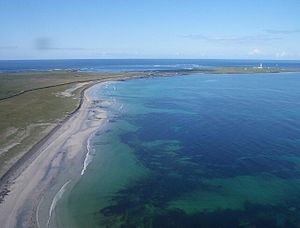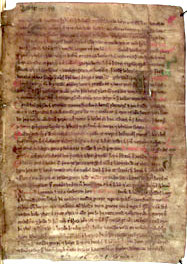Torf-Einarr facts for kids
Quick facts for kids
Einarr Rognvaldarson
|
|
|---|---|
| Earl of Orkney | |
| Title held | c. 895 to 910 or later |
| Predecessor | Hallad Rognvaldarson |
| Successor | Arnkel, Erlend and Thorfinn Torf-Einarsson |
| Native name | Torf-Einarr or Turf-Einar |
| Died | c. 910 or 930s |
| Noble family | Norse Earls of Orkney |
| Issue | Thordis, Arnkel, Erlend and Thorfinn |
| Father | Rognvald Eysteinsson |
| Mother | Unknown slave |
Einarr Rognvaldarson (fl. early 890s–around 910 AD), also known as Torf-Einarr or Turf-Einar, was an important Norse leader. He became one of the first earls of Orkney, a group of islands north of Scotland. Einarr was the son of Rognvald Eysteinsson, a powerful Norse earl, and a mother who was a slave.
Stories about Einarr's life and how he became powerful are found in old Norse sagas. These sagas even include some of his own poems! Einarr was a successful warrior. He fought for control of the Northern Isles of Scotland and even faced challenges from the King of Norway. He started a family line that ruled the islands for many centuries.
Einarr is described as a strong fighter. Some stories even compare him to the Norse god Odin. We know for sure that he was a real person. The reason for his nickname "Turf" is not fully clear.
Contents
Einarr's Family and Early Life
Einarr was the youngest son of Rognvald Eysteinsson, who was the Earl of Møre in Norway. His mother was a slave. According to old stories and history books, Rognvald's family took over the Orkney and Shetland islands in the late 800s.
Rognvald's brother, Sigurd Eysteinsson, became the first Earl of Orkney. After Sigurd died, his son Guthorm took over but also died soon after. Rognvald then sent another of his sons, Hallad, to rule the islands.
The Orkneyinga saga tells us that Einarr had five brothers. Three of them, Hallad, Einarr, and Hrollaug, were Rognvald's sons from different mothers. They were grown up while their other brothers, born to Rognvald's wife, were still young.
One of Einarr's brothers, Hrólfr, was so big that no horse could carry him. He was called "Hrólf the Walker." Some people believe he was the famous Rollo, who became an ancestor of the Dukes of Normandy.
Old texts describe Einarr as tall and not very handsome. He was also blind in one eye, but he was still very sharp-sighted.
How Einarr Became Earl
Einarr's brother Hallad struggled to control Orkney. Danish pirates kept attacking the islands. Hallad eventually gave up his title as earl and went back to Norway. Everyone thought this was quite funny.
Hallad's failure made their father Rognvald very angry. He asked his other sons if they wanted to go to the islands. Einarr, the youngest of his sons born outside of marriage, stepped forward. He offered to go.
Rognvald was not very hopeful. He said, "Considering your mother's background, you probably won't be a great ruler. But I agree, the sooner you leave and the later you return, the happier I'll be."
Rognvald gave Einarr a ship and a crew. He hoped Einarr would sail away and never come back. But Einarr proved him wrong! When he arrived in the Scottish islands, he fought and defeated two Danish pirate leaders. These pirates, Thorir Treebeard and Kalf the Scurvy, had taken over the islands. Einarr then became the earl of both Orkney and Shetland.
Einarr's Fights with Norway

After Einarr became earl, two of King Harald Finehair's sons caused trouble. These sons, Halvdan Hålegg and Gudrød Ljome, killed Einarr's father Rognvald. They trapped him in his house and set it on fire. Gudrød took Rognvald's lands, and Hálfdan sailed to Orkney and forced Einarr out.
King Harald was very upset by his sons' actions. He removed Gudrød and gave Rognvald's lands back to Einarr's brother, Thorir. Meanwhile, Einarr fought back against Hálfdan from a base in Caithness, on the Scottish mainland.
Einarr won a sea battle and then launched a strong campaign on land. He found Hálfdan hiding on North Ronaldsay island. The sagas claim that Hálfdan was captured and killed in a special ritual. While history confirms Hálfdan was killed by the Orkney islanders, the exact way he died is not fully known.
The sagas then say that King Harald wanted revenge for his son's death. He started a campaign against Einarr but could not defeat him. Eventually, Harald agreed to stop fighting. In return, Einarr and the landowners of the islands had to pay a large fine of 60 gold marks.
Einarr offered to pay the entire fine himself if the landowners gave their lands to him. They agreed. This moment was very important. It meant that the Earls of Orkney now owned all the islands, answering only to the King of Norway.
The sagas incorrectly suggest that Einarr was called "Turf-Einarr" because he taught the islanders to burn turf or peat for fuel. This practice was common long before the Norse arrived. The real reason for his nickname is still a mystery.
Einarr's Lasting Impact
Einarr ruled for a long time without further challenges. He died peacefully from a sickness. He left behind three sons: Arnkel, Erlend, and Thorfinn. They became the next earls of Orkney.
Even though Einarr had physical challenges and his mother was of low status, he created a powerful family line. This family ruled the Orkney islands until 1470.
The exact dates from this early period are sometimes unclear. Many sources say Einarr died around 910 AD. However, some historians suggest he lived into the 930s.
There are five poems in the Landnámabók that are believed to be written by Einarr. These poems describe the conflict between his family and King Harald Finehair's family. Einarr was also known as a poet. His name is even used in an old book about Norse poetry to describe a special type of poem called Torf-Einarsháttr.


